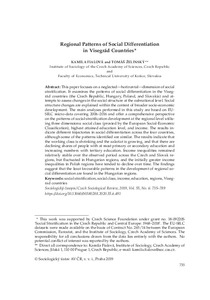Regional patterns of social differentiation in Visegrád countries

Fialová, Kamila ; Želinský, Tomáš
Sociologicky casopis - Czech Sociological Review
2019
55
6
735-790
social inequality ; income distribution ; social class ; education ; economic and social development
Czechia ; Hungary ; Poland ; Slovakia
Economic development
https://doi.org/10.13060/00380288.2020.55.6.491
English
Bibliogr.;Charts;Statistics
"This paper focuses on a neglected—horizontal—dimension of social stratification. It examines the patterns of social differentiation in the Visegrád countries (the Czech Republic, Hungary, Poland, and Slovakia) and attempts to assess changes in the social structure at the subnational level. Social structure changes are explained within the context of broader socio-economic development. The main analyses performed in this study are based on EUSILC micro-data covering 2006–2016 and offer a comprehensive perspective on the patterns of social-stratification development at the regional level utilising three dimensions: social class (proxied by the European Social-Economic Classification), highest attained education level, and income. The results indicate different trajectories in social differentiation across the four countries, although some of the patterns identified are similar. The results indicate that the working class is shrinking and the salariat is growing, and that there are declining shares of people with at most primary or secondary education and increasing numbers with tertiary education. Income inequalities remained relatively stable over the observed period across the Czech and Slovak regions, but fluctuated in Hungarian regions, and the initially greater income inequalities in Polish regions have tended to decline over time. The findings suggest that the least favourable patterns in the development of regional social differentiation are found in the Hungarian regions."
Digital;Paper
The ETUI is co-funded by the European Union. Views and opinions expressed are however those of the author(s) only and do not necessarily reflect those of the European Union or the ETUI.